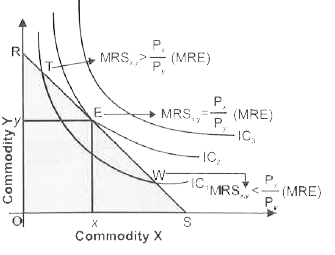State and explain the conditions of consumer's equilibrium in indifference curve analysis.
Text Solution
(i) To define consumer equilibrium, we use Interference Curve map and the budget line .
Two conditions for consumer Equilibrium
(a) Necessary Condition
Marginal Rate of Substitution = Market Rate of Exchange [PxPy]
Or , MRSx,y=Px/Py
MRS ( Market Rate of Exchange ) MRE
Or MRSx,y=MRE[PxPy]
* If MRSx,y>MRE[PxPy] ,
At point T in figure
It means the consumer.s willingness to pay for commodity X is higher than what makes values for commodity X. So, the consumer should buy more of X and less of Y to get MRS =PxPy

* If MRSx,y<MRE[PxPy], At point W in figure,
It means the consumer willingness to pay for commodity X is lesser than what market value for commodity X ,So, consumer should buy less of X and more Y to get MRS = pxpy
(b) Sufficient Condition
MRSx,y Diminishing (Convex) at a point of equilibrium i.e., when
MRSxy=MRE[PxPy]
(ii) The consumer will reach equilibrium when the budget line is tangential to the higher possible Indifference Curve, i.e. ., where necessary and sufficient condition satisfy . In the above diagram , the consumer will reach equilibrium at point E where budget line RS is tangential to the higher possible IC2
(iii) The consumer cannot move to Indifference Curve , i.e. ., IC3 as this is beyond this money income.
(iv) Even on IC2 all the other points except E are beyond his means .
(v) Hence , at point E, the consumer is in equilibrium where his satisfaction maximizes, given his income and prices of goods X and Y . In equilibrium at E , the slope of Budget line = the slope of Indifference Curve. Therefore MRSxy is equal to the ratio of the price bof two goods [PxPy] .
|
Topper's Solved these Questions
- CONSUMER EQUILIBRIUM BOOK - FULL MARKSCHAPTER - CONSUMER EQUILIBRIUM EXERCISE - MORE QUESTIONS SOLVED (VI. HIGHER ORDER THINKING SKILLS (HOTS))
9 Videos
- CONSUMER EQUILIBRIUM BOOK - FULL MARKSCHAPTER - CONSUMER EQUILIBRIUM EXERCISE - MORE QUESTIONS SOLVED (VII. VALUE BASED QUESTIONS)
1 Videos
- CONSUMER EQUILIBRIUM BOOK - FULL MARKSCHAPTER - CONSUMER EQUILIBRIUM EXERCISE - MORE QUESTIONS SOLVED (IV. TRUE OR FALSE) (Giving reasons, state whether the following statements are true or false. )
12 Videos
- COSTBOOK - FULL MARKSCHAPTER - COSTEXERCISE - NCERT TEXTBOOK QUESTIONS SOLVED
137 Videos
Similar Questions
Knowledge Check
An indifference curve is
Aconvex to the originBconcave to the originCa straight line curveDnone of theseAn indifference curve always:
ASlope downwards from left to right.BSlopes upwards from left to rightCIs parallel to the Y-axisDIs parallel to the X-axis.
Explain the conditions of consumer's equillibrium in the indifference Curve Analysis . Use diagrame.
View SolutionExplain conditions of consumer's equilibrium under indifference curve approach
View SolutionState the conditions of consumer's equilibrium in the Indifference Curve Analysis and explain the rationale behind these conditions
View SolutionState the conditions of consumer equilibrium in case of indifference curve approach
View SolutionState the conditions of consumer's equilibrium in cases of indifference curve approach ?
View SolutionDefine indifference curve.
View Solution
